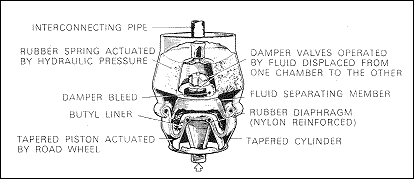
Time has shown the Hydrolastic suspension system to be as low maintenance and trouble free as its designers hailed it would be.
But even the most reliable components eventually wear and out can fail. This can be sudden and catastrophic in the relatively rare event of a rubber diaphram bursting in one of the displacer units.

More commonly though, a leak develops at one of the pipe
junctions or where the rubber hoses join the displacer and it may be slow
enough to be initially unnoticable. You may find some green fluid weeping
from these places giving an advance warning of trouble. A car in this
condition can slowly deflate over a week or a fortnight. If the suspension
does go flat the first thing to do is determine the location of the leak.
It could be the pump connection valve in the engine bay, the junctions of
the flexible hoses on either the front or rear displacer units or a
corroded metal pipe that runs beneath the floor of the car joining the
front and rear displacers. If the problem is not obvious,
it can be difficult to determine the source of the leak once
components have been removed from the car.
The displacer units are no longer available new so the only option when a displacer fails is to obtain a secondhand one to replace the failed unit.